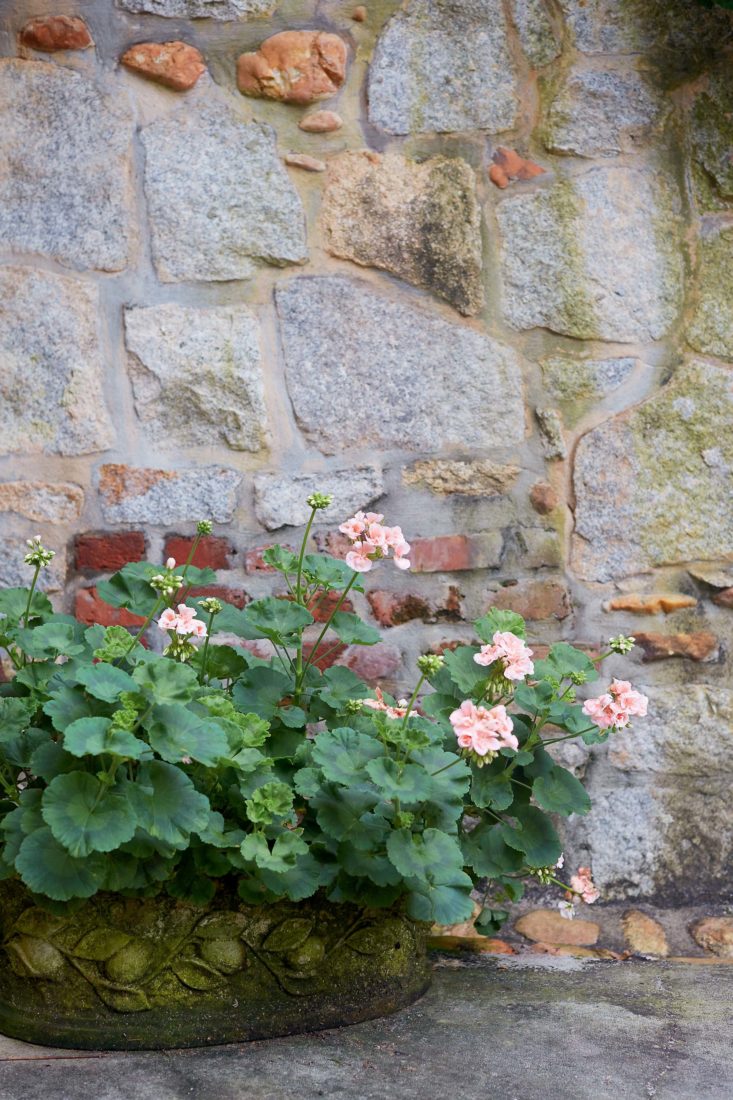Gardens
Cultivating Harmony in a Mountain Garden
A serendipitous collaboration unites the quirky facets of a home in North Carolina

Photo: Stacey Van Berkel
From left: An Endless Summer hydrangea on the rolling Mount Airy property; the home’s twentieth-century addition.
A garden, by nature, will take its sweet time getting to where it needs to be in order to best frame a house and shape a property. But the flora encircling a lovely but unusual home that John and Julie Adams were thinking of buying in Mount Airy, North Carolina, was clearly going to need a guiding hand. After reading about the miraculous turnaround Chip Callaway had performed on a Charleston, South Carolina, garden devastated by Hurricane Hugo, they thought they had found their man. Little did they know what a canny choice they had made.

Photo: Stacey Van Berkel
The home’s 1834 redbrick facade.
They sent Callaway an email with a few snapshots. On one side of the residence stood a redbrick 1834 facade as classic and staid as a Quaker manse; on the other side, a twentieth-century addition that suggested a gray stone barn sidled up against a wooden clapboard carriage house. When Callaway received the photos, he couldn’t believe his eyes. Not only had he grown up in Mount Airy, but he also knew the property well. “There was a little farrier’s cottage behind the house where my cousins and I used to go,” Callaway says. “Being rapscallion teenagers, we hid our cigarettes behind the bricks.”
The home had a lot of character but needed gardens all around to play off its many moods and statements. The plantings would also have to make the house relate better to the wooded sixteen-acre surroundings and to the prevailing landscape aesthetics of its north-central North Carolina setting—Andy Griffith’s hometown, no less. The design needed to feel structured on one side and free-flowing on the other, with just enough Mayberry to give it a sense of place.
The Adamses, who were relocating from Southern California, where they both had careers in the entertainment business, collaborated with Callaway throughout the project. “I went to school in Colonial Williamsburg,” John says. “I knew exactly the look we wanted for the more formal garden in the front of the old house.” The couple also knew they needed seating areas around the property. “We were used to conducting a lot of our lifestyle outdoors,” Julie says.

Photo: Stacey Van Berkel
From left: Garden designer Chip Callaway on the path to the kitchen garden; owners Julie and John Adams, with dogs Cessa and Jim, sit on a terrace; rosemary and basil cuttings.
Callaway envisioned the kitchen garden (“no one in North Carolina could get away with calling it a potager,” he says) down a path just beyond a loose, easygoing woodland garden by the house. He added hundreds of ferns and wildflowers to complement the new locusts and white oaks and old-growth walnuts. He also planted a Victorian flower garden nearby, filled with a constantly blooming parade of all the flowers he grew up with in Mount Airy, such as tulips and foxglove. “I wanted that whimsical, devil-may-care look about it, blowsy and effusive and not too ordered,” he says.

Photo: Stacey Van Berkel
A lavender border; the pool coping features Mount Airy granite; a fountain constructed of building materials found on the property.
Over on the original facade, Callaway embarked on John’s vision to re-create appropriate landscaping for a nineteenth-century home. “The first thing I did was rip out some century-old boxwoods that covered the facade,” Callaway says. “I felt I could breathe again.” The shrubs didn’t go far—they’re relocated on the property. “They were too beautiful to destroy,” John says. Callaway left the house free of foundation plantings, though, out of respect for the style of that earlier era, and lined the grassed front yard with old-fashioned hydrangeas and hornbeams.

Photo: Stacey Van Berkel
Potted geraniums.
Throughout, the team planted fruit and nut trees as well as evergreens to give the property strong bones for wintertime and frame the outdoor living spaces so vital to John and Julie’s lifestyle. The couple’s favorite has become the magnolia-shaded side patio constructed of granite from a quarry just outside of town, which they’ve dubbed the “wine porch.”
And, yes, the farrier’s cottage still stands. Did Callaway ever find the cigarettes he hid there decades ago? “No,” he says with a laugh, “but I haven’t stopped looking.”







